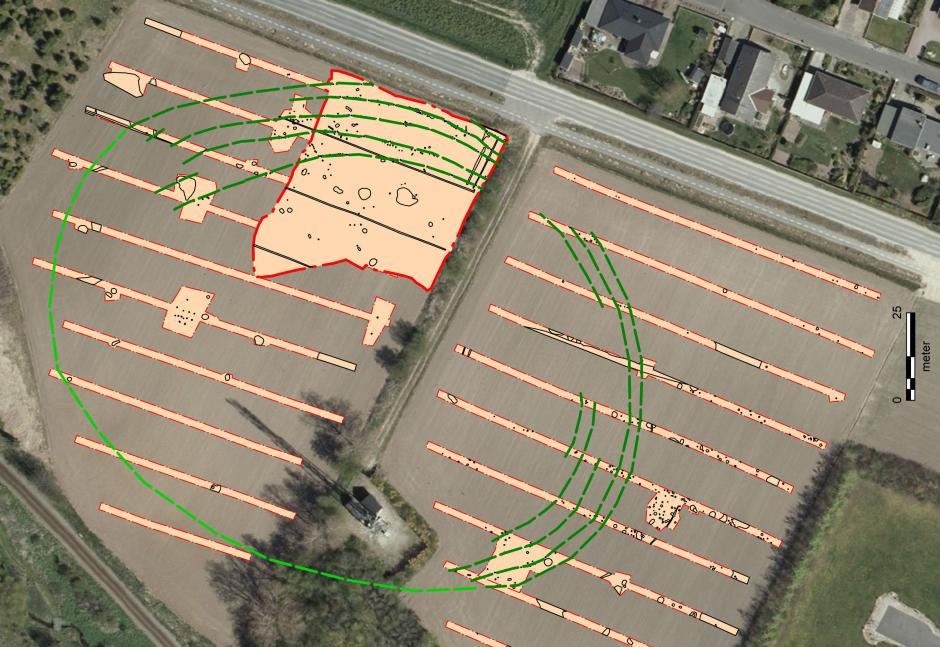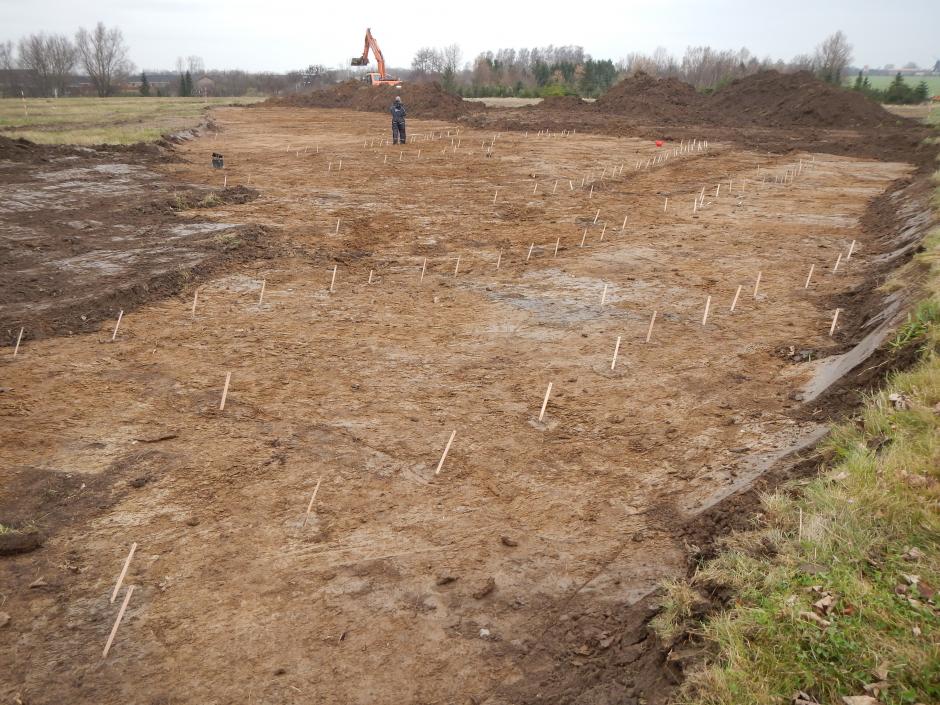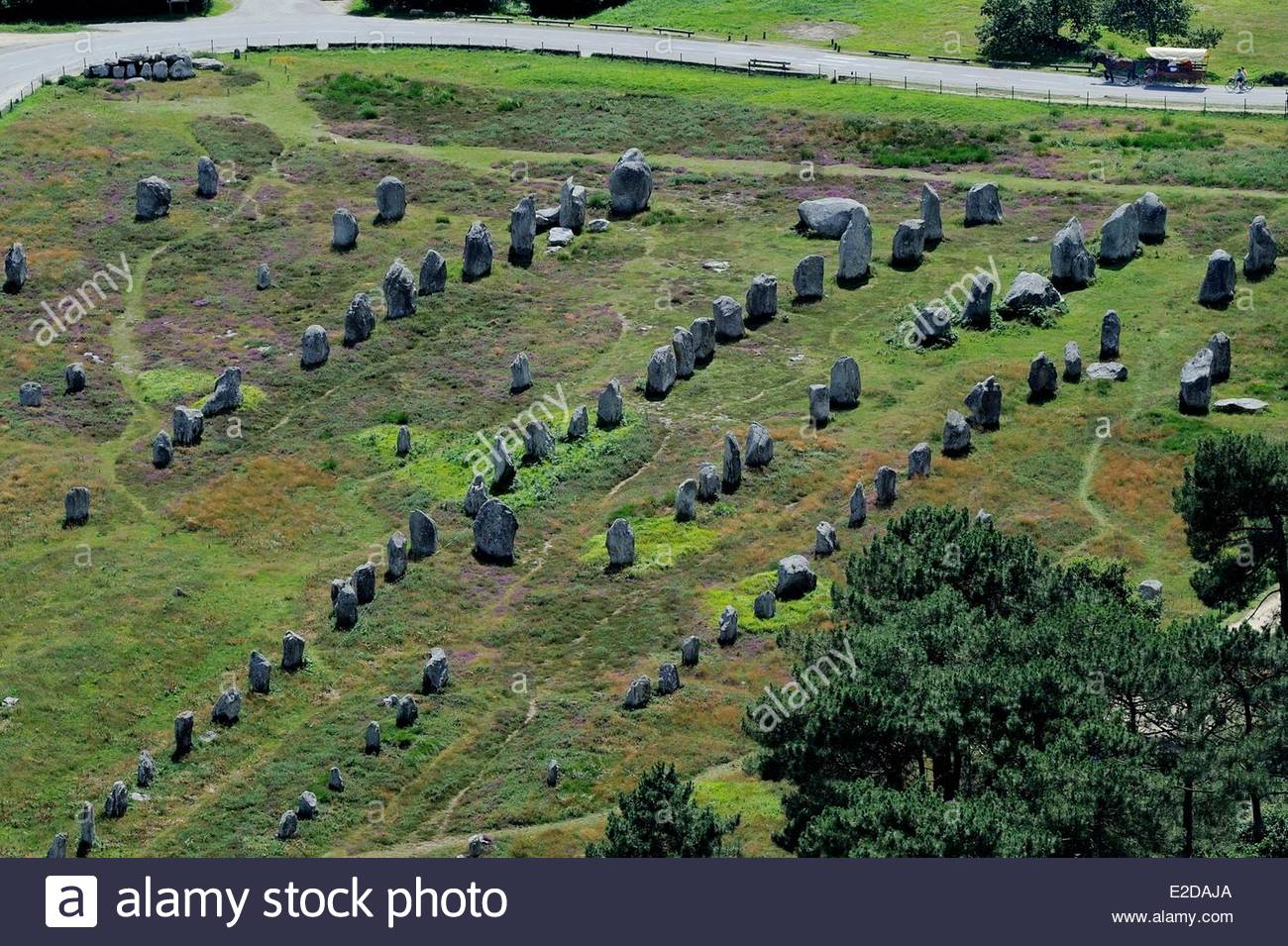It looks like you're using an Ad Blocker.
Please white-list or disable AboveTopSecret.com in your ad-blocking tool.
Thank you.
Some features of ATS will be disabled while you continue to use an ad-blocker.
15
share:


The dark green dotted lines indicate where scientists have dug their trenches and excavated the site. The position of
where the palisade is believed to have been is marked in red. The light green dashed line shows the lack of finds
[Credit: Danish Geodata Agency/Pernille Rohde Sloth]
A series of Stone Age palisade enclosures have been discovered in Denmark in recent years and archaeologists are still wondering what they were used for. Read more at archaeologynewsnetwork.blogspot.com...
What was the space used for? One of the most remarkable things about the fencing at Stevns is the way the entrances have been constructed. The fence is in fact built in five rows that extend outwards, and the opening in each row appears to be offset from the others.
Sloth suspects the uneven design was deliberate.
“The openings don’t seem to sit next to each of the post rows, and we're slightly amazed by that. But maybe it functioned as a sort of labyrinth--at least that’s how we imagine it. That way you weren’t able to look inside the common space, which may have been an advantage,” she says.
But what was going on inside the enclosure that was so secret?
Archaeologists have not yet found any structures or construction in the area that could point them towards any possible purpose for the enclosure.
Sloth is still waiting for precise dates on the Stevns site, but some of the scraps of broken pottery found on site suggest that it could date to the latter part of the Middle Neolithic Funnel Beaker Culture from 2900 BCE to 2800 BCE. The Bornholm sites are even older. “We’ve unfortunately not found any circular shaped constructions like they have on Bornholm, but the similarities between the enclosures makes me think about rituals in our finds too,” she says. With no further funding to excavate the rest of the site, it is difficult to know whether for example there ever was a sun temple on the site. Read more at archaeologynewsnetwork.blogspot.com...
They mentioned Labyrinth but not much evidence for that except a comparison to an older site called Bornholm , I wished they did a mock-up of what it may have looked like, the above gave some indication of the layout which remained me of the Megalith in France.

Site from Carnac France, not saying there is any connection but, the layout immediately popped in my mind, off course Carnac is enormously older.
This is just my opinion, but I think the diagram is incorrectly marked. (Here and in the original link)
The green lines seems to show the palisaded enclosure, and the red shows the archaeological investigation.
Just an opinion, but those red areas are marked up like trenches.
The green lines seems to show the palisaded enclosure, and the red shows the archaeological investigation.
Just an opinion, but those red areas are marked up like trenches.
a reply to: Spider879
Interesting find. As for the openings, the very first thought I had, upon reading about the placement, was that it reminds me of the descriptions of Minas Tirith, in The Lord of the Rings. There, the gates for each ring were offset for defensive purpose. No entrance in a line meant it was harder to attack. A labyrinth is certainly a possibility, of course, and would be cool, but it's not the only possibility.
Interesting find. As for the openings, the very first thought I had, upon reading about the placement, was that it reminds me of the descriptions of Minas Tirith, in The Lord of the Rings. There, the gates for each ring were offset for defensive purpose. No entrance in a line meant it was harder to attack. A labyrinth is certainly a possibility, of course, and would be cool, but it's not the only possibility.
If humanity today is any example of the mindsets back then,
I'd have to say the mazes were the prisons, if they got out, they ate and lived, if they didn't they died and population control wins.
Or if they mind Minotaur bones...
I'd have to say the mazes were the prisons, if they got out, they ate and lived, if they didn't they died and population control wins.
Or if they mind Minotaur bones...
All the answers
turf mazes
turf mazes
Historically, turf mazes were confined to Northern Europe, especially England, Germany and Denmark.
new topics
-
What Comes After January 20th
Mainstream News: 19 minutes ago -
Canada as a state .. how would it work?
General Chit Chat: 28 minutes ago -
Those stupid GRAVITE commercials
Rant: 59 minutes ago -
Let's Buy Greenland
General Chit Chat: 1 hours ago -
Planned Civil War In Britain May Be Triggered Soon
Social Issues and Civil Unrest: 4 hours ago -
Claim: General Mark Milley Approved Heat and Sound Directed Energy Weapons During 2020 Riots
Whistle Blowers and Leaked Documents: 6 hours ago
top topics
-
Claim: General Mark Milley Approved Heat and Sound Directed Energy Weapons During 2020 Riots
Whistle Blowers and Leaked Documents: 6 hours ago, 10 flags -
Planned Civil War In Britain May Be Triggered Soon
Social Issues and Civil Unrest: 4 hours ago, 5 flags -
What Comes After January 20th
Mainstream News: 19 minutes ago, 4 flags -
Let's Buy Greenland
General Chit Chat: 1 hours ago, 3 flags -
Those stupid GRAVITE commercials
Rant: 59 minutes ago, 2 flags -
Canada as a state .. how would it work?
General Chit Chat: 28 minutes ago, 0 flags
active topics
-
Gravitic Propulsion--What IF the US and China Really Have it?
General Conspiracies • 30 • : Lazy88 -
Remember These Attacks When President Trump 2.0 Retribution-Justice Commences.
2024 Elections • 133 • : Oldcarpy2 -
What Comes After January 20th
Mainstream News • 1 • : BeyondKnowledge3 -
Canada as a state .. how would it work?
General Chit Chat • 4 • : enament -
Sorry to disappoint you but...
US Political Madness • 40 • : cherokeetroy -
Let's Buy Greenland
General Chit Chat • 8 • : caterpillage -
Those stupid GRAVITE commercials
Rant • 2 • : BeyondKnowledge3 -
January 6th report shows disturbing trend (nobody is shocked)
US Political Madness • 72 • : JadedGhost -
-@TH3WH17ERABB17- -Q- ---TIME TO SHOW THE WORLD--- -Part- --44--
Dissecting Disinformation • 3954 • : Thoughtful3 -
Claim: General Mark Milley Approved Heat and Sound Directed Energy Weapons During 2020 Riots
Whistle Blowers and Leaked Documents • 20 • : NoCorruptionAllowed
15
